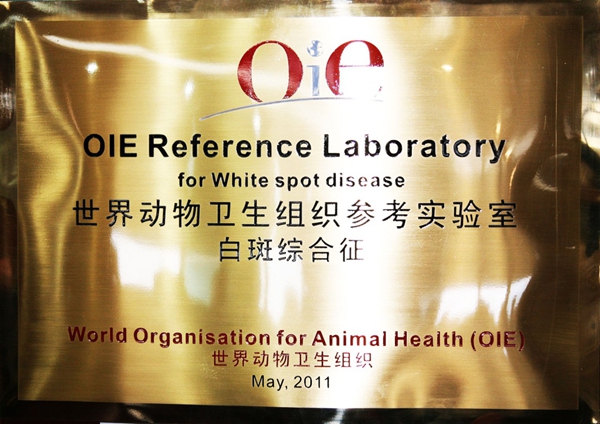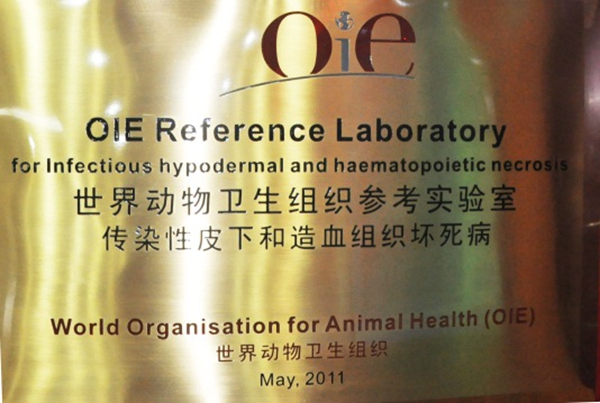Research Platform
OIE Reference Laboratories
OIE Reference Laboratories
are designated to pursue all the scientific and technical problems relating to a named disease. The Expert, responsible to the OIE and its Member Countries with regard to the disease, should be a leading and active researcher helping the Reference Laboratory to provide scientific and technical assistance and expert advice on topics linked to diagnosis and control of the disease for which the Reference Laboratory is responsible. Reference Laboratories should also provide scientific and technical training for personnel from Member Countries, and coordinate scientific and technical studies in collaboration with other laboratories or organisations, including through the OIE Laboratory Twinning programe.
OIE Designated Expert for WSD & IHHN
Dr. Jie HUANG,a Senior Researcher from Yellow Sea Fisheries Research Institute (YSFRI), Chinese Academy of Fishery Sciences (CAFS); the Chief Scientist for the aquatic animal disease control in CAFS; OIE Designated Expert for White spot disease (WSD) and Infectious and haematopoietic necrosis (IHHN). He has been conducting research projects on the diagnostics, epidemiology, infection mechanism, and control technology of shrimp for 26 years. He actively promotes biosecurity technological system for aquaculture industry of China in recent years.
Research on WSD

1993, First found in mainland China and confirmed that the pathogen of shrimp WSD is virus
1995, The invention of the diagnosis of WSD T-E staining, WSD pathological study
1997, Dot blot hybridization detection kit and commercial production of the successful development of WSD
1999, The earliest research to WSSV and host recognition mechanism, a WSSV receptor identified
2001, WSSV 5 national standards and industry standards
2002, Investigation on the epidemic situation of WSD in the 9 coastal provinces of China
2004, Development of gene chip successfully shrimp virus high-throughput detection
2006, To reveal the molecular mechanism of WSSV invasion
2008, Development of rapid diagnostic kit for LAMP success shrimp virus detection technology
2009, National survey and sample collection of shrimp diseases in 4 consecutive years
2010, Screening of resistant microbial strains and to carry out development and Application
2011-2012, Application of "biological floc" technique to control viral disease of penaeid shrimp
Research on IHHN

2002, Investigation of IHHN disease nationwide
2004, Research and development of detection technology of dot blot hybridization of IHHNV
2005, Establishment of PCR detection method IHHNV
2006, Research and development of the simultaneous detection of one-step multiplex PCR method of WSSV and IHHNV
2007, First reported the existence of IHHNV in cultured shrimp in China
2010, To carry out the pathogenic mechanism and prevention of IHHNV
2011, IHHNV national standards
Terms of Reference
To use, promote and disseminate diagnostic methods validated according to OIE Standards;
To recommend the prescribed and alternative tests or vaccines as OIE Standards;
To develop reference material in accordance with OIE requirements, and implement and promote the application of OIE Standards;
To store and distribute to national laboratories biological reference products and any other reagents used in the diagnosis and control of the designated pathogens or diseases;
To develop, standardise and validate according to OIE Standards new procedures for diagnosis and control of the designated pathogens or diseases;
To provide diagnostic testing facilities, and, where appropriate, scientific and technical advice on disease control measures to OIE Member Countries;
To carry out and/or coordinate scientific and technical studies in collaboration with other laboratories, centres or organisations;
To collect, process, analyse, publish and disseminate epizootiological data relevant to the designated pathogens or diseases;
To provide scientific and technical training for personnel from OIE Member Countries;
To maintain a system of quality assurance, biosafety and biosecurity relevant for the pathogen and the disease concerned;
To organise and participate in scientific meetings on behalf of the OIE;
To establish and maintain a network with other OIE Reference Laboratories designated for the same pathogen or disease and organise regular inter-laboratory proficiency testing to ensure comparability of results;
To organise inter-laboratory proficiency testing with laboratories other than OIE Reference Laboratories for the same pathogens and diseases to ensure equivalence of results;
To place expert consultants at the disposal of the OIE.
